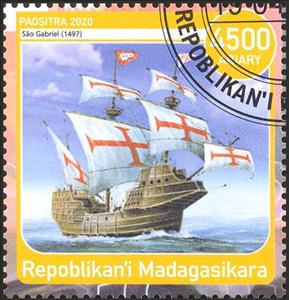Stamp: Sao Gabriel (1497) (Madagascar 2020)
Sao Gabriel (1497) (Madagascar 2020)
19 April (Madagascar ) within release Ships (2020) goes into circulation Stamp Sao Gabriel (1497) face value 4,500 Malagasy ariary
| Stamp Sao Gabriel (1497) in catalogues | |
|---|---|
| Colnect codes: | Col: MG 2020-12/3 |
Stamp is horizontal format.
Also in the issue Ships (2020):
- Mini Sheet - Aircraft Carriers (Second World War) face value 23,200;
- Souvenir Sheet - Aircraft Carriers (Second World War) face value 22,000;
- Stamp - AMBRA. Class Perla face value 3,500;
- Stamp - Aurore face value 4,500;
- Stamp - Batavia (1628) face value 2,000;
- Stamp - Battle of Focchies (1649) face value 4,500;
- Stamp - Battle of Gibraltar (1607) face value 3,500;
- Stamp - Battle of Haarlemmermeer (1573) face value 2,000;
- Stamp - Battle of Oresund (1658) face value 7,200;
- Stamp - Battle of Scheveningen (1653) face value 6,000;
- Stamp - Battle of Solebay (1672) face value 22,000;
- Stamp - Bismarck. Class Bismarck face value 6,000;
- Stamp - Crusader ship XII-XIV century face value 2,000;
- Stamp - Graf Zeppelin. Class Graf Zeppelin face value 4,500;
- Stamp - Gremyashchy. Class Gnevny face value 2,000;
- Stamp - Henry Grace (1514) face value 6,000;
- Stamp - HMS Dreadnought face value 2,000;
- Stamp - HMS Fiji (58). Class Crown Colony face value 3,500;
- Stamp - HMS Illustrious (87). Class Illustrious face value 2,000;
- Stamp - HMS Royal Charles (1655) face value 3,500;
- Stamp - HMS Victory (1805) face value 22,000;
- Stamp - Hungarian galley XV century face value 3,500;
- Stamp - I-168. Class Kaidai face value 6,000;
- Stamp - Mikasa face value 6,000;
- Stamp - Nao Victoria (1519) face value 7,200;
- Stamp - Normandie face value 3,500;
- Mini Sheet - Old Sailboats (Middle Ages) face value 23,200;
- Souvenir Sheet - Old Sailboats (Middle Ages) face value 22,000;
- Mini Sheet - Old Sailboats (Modern Era) face value 23,200;
- Souvenir Sheet - Old Sailboats (Modern Era) face value 22,000;
- Mini Sheet - Old Sailboats (Modern Era) face value 23,200;
- Souvenir Sheet - Old Sailboats (Modern Era) face value 22,000;
- Stamp - ORP Sokol (N.97). Class Umpire face value 2,000;
- Stamp - P-3 ISKRA. Class Pravda face value 4,500;
- Stamp - Roma. Class Littorio face value 4,500;
- Stamp - Salvador del Mundo (1787) face value 4,500;
- Stamp - Santa Maria (1492) face value 22,000;
- Stamp - Sao Gabriel (1497) face value 4,500;
- Stamp - Shinano. Class Yamato face value 3,500;
- Stamp - Shokaku. Class Shokaku face value 7,200;
- Stamp - SMS König face value 22,000;
- Stamp - SMS Markgraf face value 7,200;
- Stamp - Soleil Royal (1810) face value 7,200;
- Mini Sheet - Submarines (Second World War) face value 23,200;
- Souvenir Sheet - Submarines (Second World War) face value 22,000;
- Stamp - Type VIIC/41. Version Atlantique face value 22,000;
- Stamp - USS Arizona (BB-39). Class Pennsylvania face value 7,200;
- Stamp - USS Boston (1799) face value 6,000;
- Stamp - USS Enterprise (CV-6). Class Yorktown face value 6,000;
- Stamp - USS Gato (SS-212). Class Gato face value 7,200;
- Stamp - USS Yorktown (CV-10). Class Essex face value 22,000;
- Mini Sheet - Warships (First World War) face value 23,200;
- Souvenir Sheet - Warships (First World War) face value 22,000;
- Mini Sheet - Warships (Second World War) face value 23,200;
- Souvenir Sheet - Warships (Second World War) face value 22,000;
- Stamp - Yamato. Class Yamato face value 22,000;
Stamp Sao Gabriel (1497) it reflects the thematic directions:
In the history of Europe, the Middle Ages or medieval period (also spelt mediaeval or mediæval) lasted approximately from 500 AD to 1500, although some prefer other start and end dates. The Middle Ages is the second of the three traditional divisions of Western history: antiquity, medieval, and modern. Major developments include the predominance of agriculture in the economy, the exploitation of the peasantry, slow interregional communication, the importance of personal relationships in power structures, and the weakness of state administration. The period is sometimes subdivided into the Early, High, and Late Middle Ages, and the early medieval period is alternatively referred to as the Dark Ages.
A modern sailing ship or sailship is any large wind-powered vessel. Traditionally a sailing ship (or simply ship) is a sailing vessel that carries three or more masts with square sails on each. Large sailing vessels that are not ship-rigged may be more precisely referred to by their sail rig, such as schooner, barque (also spelled "bark"), brig, barkentine, brigantine or sloop. There are many different types of sailing ships, but they all have certain basic things in common. Every sailing ship has a hull, rigging and at least one mast to hold up the sails that use the wind to power the ship. The crew who sail a ship are called sailors or hands. They take turns to take the watch, the active managers of the ship and her performance for a period. Watches are traditionally four hours long. Some sailing ships use traditional ship's bells to tell the time and regulate the watch system, with the bell being rung once for every half hour into the watch and rung eight times at watch end (a four-hour watch). Ocean journeys by sailing ship can take many months, and a common hazard is becoming becalmed because of lack of wind, or being blown off course by severe storms or winds that do not allow progress in the desired direction. A severe storm could lead to shipwreck, and the loss of all hands. Sailing ships are limited in their maximum size compared to ships with heat engines, so economies of scale are also limited. The heaviest sailing ships (limited to those vessels for which sails were the primary means of propulsion) never exceeded 14,000 tons displacement. Sailing ships are therefore also very limited in the supply capacity of their holds, so they have to plan long voyages carefully to include many stops to take on provisions and, in the days before watermakers, fresh water.
A ship is a large watercraft that travels the world's oceans and other sufficiently deep waterways, carrying passengers or goods, or in support of specialized missions, such as defense, research and fishing. Historically, a "ship" was a sailing vessel with at least three square-rigged masts and a full bowsprit. Ships are generally distinguished from boats, based on size, shape and load capacity.



